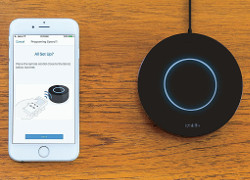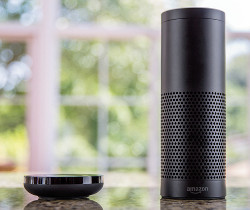Lights Off, Fan On: Automating Home Theater Ambiance

Touch control of the things that enhance our entertainment experience is pretty cool, right? Not cool enough, actually. The screen app has already been eclipsed by something even cooler.
Let me explain.
Doing my part to fight climate change, I made the switch from air conditioners to ceiling fans. I have six fans hovering over various rooms, including the living room, which doubles as the home theater. The wide-span, five-blade fan rotates in tandem with almost all our TV viewing from May through October. Until now, it’s been operated entirely from a dedicated RF remote kept near the sofa.
 Compared with other gadgetry at trade shows, ceiling fans are decidedly low tech. But when I came across the Olibra booth, I was impressed by the company’s pitch that you didn’t need a smart fan to make it Wi-Fi-compatible. Even legacy fans could be app-controlled by the Bond, a $99 hockey-puck-like emitter. You plug it into an electrical outlet and install the free Bond app on your iOS or Android device.
Compared with other gadgetry at trade shows, ceiling fans are decidedly low tech. But when I came across the Olibra booth, I was impressed by the company’s pitch that you didn’t need a smart fan to make it Wi-Fi-compatible. Even legacy fans could be app-controlled by the Bond, a $99 hockey-puck-like emitter. You plug it into an electrical outlet and install the free Bond app on your iOS or Android device.
You point your fan’s remote at the Bond, which searches its database. The Bond had no difficulty identifying the fans in my reading room and home office. Both were RF devices operable from other rooms. (If your remote is IR, the Bond will need line-of-sight to that particular fan.) Fans deploying only wall switches or pull-down chains are not compatible.
The Bond stumbled when I tried to get it to recognize the Hampton Bay fan in my living room, home to movie night and the raison d’être for covering the product in S∓V. Chris Merck, Olibra’s chief engineer, called to explain that, unlike my other fan remotes, the model in my living room incorporates an LCD readout. I was advised to keep pressing a remote button rather than just holding it down to see if the Bond could capture the code. That worked.
I successfully commanded my fans over the internet using the app on an iPad away from home. It’s unclear why I’d want to do that except, perhaps, to cool a pet or turn on a light to give the impression that someone was home.
 In the support call, Merck told me something that was an aha! moment. He said that 90 percent of his users put away the app and operate the Bond entirely through an Amazon Echo or Google
Home smart speaker. “I say, ‘Alexa, turn on kitchen fan.’ It’s what I prefer to do at home. You’ve got both hands full cooking. It’s very convenient to just use your voice.”
In the support call, Merck told me something that was an aha! moment. He said that 90 percent of his users put away the app and operate the Bond entirely through an Amazon Echo or Google
Home smart speaker. “I say, ‘Alexa, turn on kitchen fan.’ It’s what I prefer to do at home. You’ve got both hands full cooking. It’s very convenient to just use your voice.”
Can you understand my dismay? Here I am writing a monthly column largely about apps on mobile devices, and now I’m being told by a company that makes apps that its app is not essential. I felt like calling it quits. But I didn’t do that after keyboards and mice took a back seat to palm-size screens. And I didn’t do it after the natural world succumbed to the virtual world. So, I’m not about to give up on screen apps just yet. But clearly — at least in the home — the next big interface will be spoken rather than touched.
Visit bondhome.io.














































